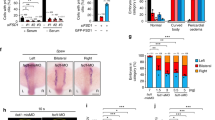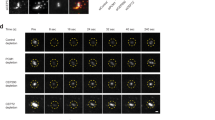Abstract
In animal cells, the centrosome nucleates and anchors microtubules (MT), forming their radial array. During interphase centrosome-derived MT, aster can either team up with other MT network or function in an autonomous manner. What is the function of the centrosome-derived MT aster? We suggested that it might play an important role in the formation of the primary cilium, the organelle obligatorily associated with the centrosome. PCM-1 (PeriCentriolar Matrix 1) protein, which participates in the organization of the primary cilium, is a part of pericentiolar satellites. They are transported to the centrosome along MTs by the motor protein dynein in a complex with its cofactor dynactin. Previously, we showed that SLK/LOSK phosphorylated the p150Glued subunit of dynactin, thus promoting its centrosomal targeting followed by its participation in the retention of microtubules. Here, we found that under the repression of SLK/LOSK activity, the PCM-1 protein lost its pericentrosomal localization and was being dispersed throughout the cytoplasm. Despite that the alanine and glutamine mutants of p150Glued had opposite effects on PCM-1 localization, they associated with PCM-1 to the same extent. The occurrence of primary cilia also significantly decreased when SLK/LOSK was repressed. These defects also correlated with a disturbance of the long-range transport in cells, whereas dynein-depending motility was intact. Treatment with the GSK-3β kinase inhibitor also resulted in the loss of the centrosome-derived MT aster, dispersion of PCM-1 over the cytoplasm, and reduction of primary cilia occurrence. Thus, kinases involved in the centrosome-derived MT aster regulation can indirectly control the formation of primary cilia in cells.







Similar content being viewed by others
References
Balczon R, Bao L, Zimmer WE (1994) PCM-1, a 228-kD centrosome autoantigen with a distinct cell cycle distribution. J Cell Biol 124:783–793
Ben-Tekaya H, Miura K, Pepperkok R, Hauri HP (2005) Live imaging of bidirectional traffic from the ERGIC. J Cell Sci 18:357–367
Burakov A, Kovalenko O, Semenova I, Zhapparova O, Nadezhdina E, Rodionov V (2008a) Cytoplasmic dynein is involved in the retention of MTs at the centrosome in interphase cells. Traffic 9:472–480
Burakov AV, Zhapparova ON, Kovalenko OV, Zinovkina LA, Potekhina ES, Shanina NA, Weiss DG, Kuznetsov SA, Nadezhdina ES (2008b) Ste20-related protein kinase LOSK (SLK) controls MT radial array in interphase. Mol Biol Cell 19:1952–1961
Cantagrel V, Silhavy JL, Bielas SL, Swistun D, Marsh SE, Bertrand JY, Audollent S, Attié-Bitach T, Holden KR, Dobyns WB, Traver D, Al-Gazali L, Ali BR, Lindner TH, Caspary T, Otto EA, Hildebrandt F, Glass IA, Logan CV, Johnson CA, Bennett C, Brancati F, International Joubert Syndrome Related Disorders Study Group, Valente EM, Woods CG, Gleeson JG (2008) Mutations in the cilia gene ARL13B lead to the classical form of Joubert syndrome. Am J Hum Genet 83:170–179. https://doi.org/10.1016/j.ajhg.2008.06.023
Dammermann A, Merdes A (2002) Assembly of centrosomal proteins and microtubule organization depends on PCM-1. J Cell Biol 159:255–266
Fargier G, Favard C, Parmeggiani A, Sahuquet A, Mérezègue F, Morel A, Denis M, Molinari N, Mangeat PH, Coopman PJ, Montcourrier P (2013) Centrosomal targeting of Syk kinase is controlled by its catalytic activity and depends on MTs and the dynein motor. FASEB J 27:109–122. https://doi.org/10.1096/fj.11-202465
Fokin AI, Brodsky IB, Burakov AV, Nadezhdina ES (2014) Interaction of early secretory pathway and Golgi membranes with microtubules and microtubule motors. Biochem Mosc 79:879–893. https://doi.org/10.1134/S0006297914090053
Fokin AI, Klementeva TS, Nadezhdina ES, Burakov AV (2016) SLK/LOSK kinase regulates cell motility independently of microtubule organization and Golgi polarization. Cytoskeleton (Hoboken) 73:83–92. https://doi.org/10.1002/cm.21276
Fumoto K, Hoogenraad CC, Kikuchi A (2006) GSK-3beta-regulated interaction of BICD with dynein is involved in MT anchorage at centrosome. EMBO J 25:5670–5682
Gao FJ, Hebbar S, Gao XA, Alexander M, Pandey JP, Walla MD, Cotham WE, King SJ, Smith DS (2015) GSK-3β phosphorylation of cytoplasmic dynein reduces Ndel1 binding to intermediate chains and alters dynein motility. Traffic 16:941–961. https://doi.org/10.1111/tra.12304
Gavilan MP, Gandolfo P, Balestra FR, Arias F, Bornens M, Rios RM (2018) The dual role of the centrosome in organizing the microtubule network in interphase. EMBO Rep 19:pii: e45942. https://doi.org/10.15252/embr.201845942
Gerdes JM, Davis EE, Katsanis N (2009) The vertebrate primary cilium in development, homeostasis, and disease. Cell 137:32–45. https://doi.org/10.1016/j.cell.2009.03.023
Gillingham AK, Munro S (2000) The PACT domain, a conserved centrosomal targeting motif in the coiled-coil proteins AKAP450 and pericentrin. EMBO Rep 1:524–529
Guilluy C, Rolli-Derkinderen M, Loufrani L, Bourge A, Henrion D, Sabourin L, Loirand G, Pacaud P (2008) Ste20-related kinase SLK phosphorylates Ser188 of RhoA to induce vasodilation in response to angiotensin II type 2 receptor activation. Circ Res 102:1265–1274. https://doi.org/10.1161/CIRCRESAHA.107.164764
Gupta GD, Coyaud É, Gonçalves J, Mojarad BA, Liu Y, Wu Q, Gheiratmand L, Comartin D, Tkach JM, Cheung SW, Bashkurov M, Hasegan M, Knight JD, Lin ZY, Schueler M, Hildebrandt F, Moffat J, Gingras AC, Raught B, Pelletier L (2015) A dynamic protein interaction landscape of the human centrosome-cilium interface. Cell 163:1484–1499. https://doi.org/10.1016/j.cell.2015.10.065
Hori A, Barnouin K, Snijders AP, Toda T (2016) A non-canonical function of Plk4 in centriolar satellite integrity and ciliogenesis through PCM1 phosphorylation. EMBO Rep 17:326–337. https://doi.org/10.15252/embr.201541432
Hori A, Toda T (2017) Regulation of centriolar satellite integrity and its physiology. Cell Mol Life Sci 74:213–229. https://doi.org/10.1007/s00018-016-2315-x
Jia Y, Fong KW, Choi YK, See SS, Qi RZ (2013) Dynamic recruitment of CDK5RAP2 to centrosomes requires its association with dynein. PLoS One 8:e68523. https://doi.org/10.1371/journal.pone.00685
Johnson TM, Antrobus R, Johnson LN (2008) Plk1 activation by Ste20-like kinase (Slk) phosphorylation and polo-box phosphopeptide binding assayed with the substrate translationally controlled tumor protein (TCTP). Biochemistry 47:3688–3696. https://doi.org/10.1021/bi702134c
Kim JC, Badano JL, Sibold S, Esmail MA, Hill J, Hoskins BE, Leitch CC, Venner K, Ansley SJ, Ross AJ (2004) The Bardet-Biedl protein BBS4 targets cargo to the pericentriolar region and is required for microtubule anchoring and cell cycle progression. Nat Genet 36:462–470
Kim J, Krishnaswami SR, Gleeson JG (2008) CEP290 interacts with the centriolar satellite component PCM-1 and is required for Rab8 localization to the primary cilium. Hum Mol Genet 17:3796–3805
Kodani A, Tonthat V, Wu B, Sütterlin C (2010) Par6 alpha interacts with the dynactin subunit p150Glued and is a critical regulator of centrosomal protein recruitment. Mol Biol Cell 21:3376–3385
Kubo A, Sasaki H, Yuba-Kubo A, Tsukita S, Shiina N (1999) Centriolar satellites: molecular characterization, ATP-dependent movement toward centrioles and possible involvement in ciliogenesis. J Cell Biol 147:969–980
Lopes CA, Prosser SL, Romio L, Hirst RA, O’Callaghan C, Woolf AS, Fry AM (2011) Centriolar satellites are assembly points for proteins implicated in human ciliopathies, including oral-facial-digital syndrome 1. J Cell Sci 124:600–612. https://doi.org/10.1242/jcs.077156
Lu L, Hong W (2003) Interaction of Arl1-GTP with GRIP domains recruits autoantigens Golgin-97 and Golgin-245/p230 onto the Golgi. Mol Biol Cell 14:3767–3781
Machicoane M, de Frutos CA, Fink J, Rocancourt M, Lombardi Y, Garel S, Piel M, Echard A (2014) SLK-dependent activation of ERMs controls LGN-NuMA localization and spindle orientation. J Cell Biol 205:791–799. https://doi.org/10.1083/jcb.201401049
Mariappan A, Soni K, Schorpp K, Zhao F, Minakar A, Zheng X, Mandad S, Macheleidt I, Ramani A, Kubelka T, Dawidowski M, Golfmann K, Wason A, Yang C, Simons J, Schmalz HG, Hyman AA, Aneja R, Ullrich R, Urlaub H, Odenthal M, Büttner R, Li H, Sattler M, Hadian K, Gopalakrishnan J (2019) Inhibition of CPAP-tubulin interaction prevents proliferation of centrosome-amplified cancer cells. EMBO J 38:e99876. https://doi.org/10.15252/embj.201899876
Munro S, Nichols BJ (1999) The GRIP domain - a novel Golgi-targeting domain found in several coiled-coil proteins. Curr Biol 9:377–380. https://doi.org/10.1016/S0960-9822(99)80166-3
Musa H, Orton C, Morrison EE, Peckham M (2003) Microtubule assembly in cultured myoblasts and myotubes following nocodazole induced microtubule depolymerisation. J Muscle Res Cell Motil 24:301–308
Nachury MV, Loktev AV, Zhang Q, Westlake CJ, Peränen J, Merdes A, Slusarski DC, Scheller RH, Bazan JF, Sheffield VC, Jackson PK (2007) A core complex of BBS proteins cooperates with the GTPase Rab8to promote ciliary membrane biogenesis. Cell 129:1201–1213
Olsen JV, Vermeulen M, Santamaria A, Kumar C, Miller ML, Jensen LJ, Gnad F, Cox J, Jensen TS, Nigg EA, Brunak S, Mann M (2010) Quantitative phosphoproteomics reveals widespread full phosphorylation site occupancy during mitosis. Sci Signal 3(104):ra3. https://doi.org/10.1126/scisignal.2000475
Quintyne NJ, Gill SR, Eckley DM, Crego CL, Compton DA, Schroer TA (1999) Dynactin is required for microtubule anchoring at centrosomes. J Cell Biol 147:321–334
Quizi JL, Baron K, Al-Zahrani KN, O'Reilly P, Sriram RK, Conway J, Laurin AA, Sabourin LA (2013) SLK-mediated phosphorylation of paxillin is required for focal adhesion turnover and cell migration. Oncogene 32:4656–4663. https://doi.org/10.1038/onc.2012.488
Staples CJ, Myers KN, Beveridge RD, Patil AA, Howard AE, Barone G, Lee AJ, Swanton C, Howell M, Maslen S, Skehel JM, Boulton SJ, Collis SJ (2014) Ccdc13 is a novel human centriolar satellite protein required for ciliogenesis and genome stability. J Cell Sci 127:2910–2919. https://doi.org/10.1242/jcs.147785
Thoma CR, Frew IJ, Hoerner CR, Montani M, Moch H, Krek W (2007) pVHL and GSK3beta are components of a primary cilium-maintenance signalling network. Nat Cell Biol 9:588–595
Tripathy SK, Weil SJ, Chen C, Anand P, Vallee RB, Gross SP (2014) Autoregulatory mechanism for dynactin control of processive and diffusive dynein transport. Nat Cell Biol 16:1192–1201. https://doi.org/10.1038/ncb3063
Viswanatha R, Ohouo PY, Smolka MB, Bretscher A (2012) Local phosphocycling mediated by LOK/SLK restricts ezrin function to the apical aspect of epithelial cells. J Cell Biol 199:969–984. https://doi.org/10.1083/jcb.201207047
Wheway G, Nazlamova L, Hancock JT (2018) Signaling through the primary cilium. Front Cell Dev Biol 6(8). https://doi.org/10.3389/fcell.2018.00008
Young A, Dictenberg JB, Purohit A, Tuft R, Doxsey SJ (2000) Cytoplasmic dynein-mediated assembly of pericentrin and gamma tubulin onto centrosomes. Mol Biol Cell 11:2047–2056
Zhapparova ON, Burakov AV, Nadezhdina ES (2007) The centrosome keeps nucleating microtubules but looses the ability to anchor them after the inhibition of dynein-dynactin complex. Biochem Mosc 72:1233–1240
Zhapparova ON, Fokin AI, Vorobyeva NE, Bryantseva SA, Nadezhdina ES (2013) Ste20-like protein kinase SLK (LOSK) regulates microtubule organization by targeting dynactin to the centrosome. Mol Biol Cell 24:3205–3214. https://doi.org/10.1091/mbc.E13-03-0137
Acknowledgments
The authors are very grateful to Prof. Andrea Merdes (Université Paul Sabatier/CNRS, Toulouse) for the great anti-PCM-1 antibody. We also thank Dr. Hans-Peter Hauri (University of Basel) for DNA construct, Dr. Ilya Brodsky (Moscow State University) for DNA constructs and fruitful discussions, and Ekaterina Ryabkova for technical assistance.
Funding
The project was financially supported by the President of Russain Federation grant for young PhD researchers (MK-8703.2010.4) and grants from the Russian Basic Research Foundation (08-04-01697-a, 11-04-01022-a, and 18-04-00742-a).
Author information
Authors and Affiliations
Corresponding author
Ethics declarations
Conflict of interest
The authors declare that they have no conflict of interest.
Additional information
Handling Editor: Pavel Dráber
Publisher’s note
Springer Nature remains neutral with regard to jurisdictional claims in published maps and institutional affiliations.
Rights and permissions
About this article
Cite this article
Fokin Artem, I., Zhapparova Olga, N., Burakov Anton, V. et al. Centrosome-derived microtubule radial array, PCM-1 protein, and primary cilia formation. Protoplasma 256, 1361–1373 (2019). https://doi.org/10.1007/s00709-019-01385-z
Received:
Accepted:
Published:
Issue Date:
DOI: https://doi.org/10.1007/s00709-019-01385-z




